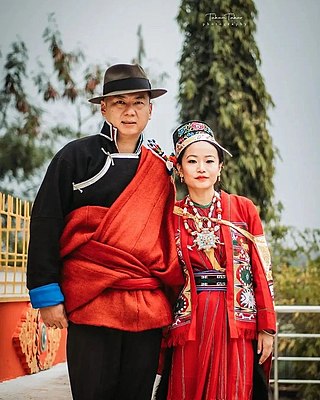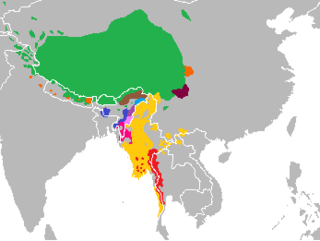Related Research Articles

Asia is home to hundreds of languages comprising several families and some unrelated isolates. The most spoken language families on the continent include Austroasiatic, Austronesian, Japonic, Dravidian, Indo-European, Afroasiatic, Turkic, Sino-Tibetan, Kra–Dai and Koreanic. Many languages of Asia, such as Chinese, Sanskrit, Arabic, Tamil or Telugu, have a long history as a written language.

The Monpa (Tibetan: མོན་པ་, Wylie: mon pa, THL: mön pa are a major people of Arunachal Pradesh in northeastern India and one of the 56 officially recognized ethnic groups in China. Most Monpas live in the Indian state of Arunachal Pradesh, with a population of 50,000, centered in the districts of Tawang and West Kameng. As of 2020 there were 11,143 Monpa people living in Tsona City in the southern Tibet Autonomous Region, where they are known as Menba. Of the 45,000 Monpas who live in Arunachal Pradesh, about 20,000 of them live in Tawang district, where they constitute about 97% of the district's population, and almost all of the remainder can be found in the West Kameng district, where they form about 77% of the district's population. A small number of them may be found in bordering areas of East Kameng and Bhutan.
The Buguns are one of the earliest recognized schedule tribe of India, majority of them, inhabiting the Singchung Sub-Division of West Kameng District of Arunachal Pradesh. Buguns live in several exogamous clans. Traditionally, the predominant occupation was agriculture, supported with other allied activities like fishing and hunting, cattle rearing etc. Buguns have their own folklores, songs, dances, music and rituals. A rare bird, the Bugun liocichla, was named after the tribe.
The Indian state of Arunachal Pradesh has a total population of roughly 1.4 million on an area of 84,000 km2, amounting to a population density of about 17 pop./km2. The "indigenous groups" account for about two thirds of population, while immigrants, mostly of Bengali/Hindi belt origin, account for the remaining third.
Tshangla is a Sino-Tibetan language of the Bodish branch closely related to the Tibetic languages. Tshangla is primarily spoken in Eastern Bhutan and acts as a lingua franca in the region; it is also spoken in the adjoining Tawang tract in the Indian state of Arunachal Pradesh and the Pemako region of Tibet. Tshangla is the principal pre-Tibetan language of Bhutan.
The Hrusish or Southeast Kamengic languages possibly constitute a Sino-Tibetan branch in Arunachal Pradesh, northeast India. They are Hruso (Aka) and Mijiic. In Glottolog, Hammarström, et al. does not accept Hrusish, and considers similarities between Hruso and Miji to be due to loanwords.
The Kho-Bwa languages, also known as Kamengic, are a small family of languages, or pair of families, spoken in Arunachal Pradesh, northeast India. The name Kho-Bwa was originally proposed by George van Driem (2001). It is based on the reconstructed words *kho ("water") and *bwa ("fire"). Blench (2011) suggests the name Kamengic, from the Kameng area of Arunachal Pradesh. Alternatively, Anderson (2014) refers to Kho-Bwa as Northeast Kamengic.

The Tibeto-Burman languages are the non-Sinitic members of the Sino-Tibetan language family, over 400 of which are spoken throughout the Southeast Asian Massif ("Zomia") as well as parts of East Asia and South Asia. Around 60 million people speak Tibeto-Burman languages. The name derives from the most widely spoken of these languages, Burmese and the Tibetic languages, which also have extensive literary traditions, dating from the 12th and 7th centuries respectively. Most of the other languages are spoken by much smaller communities, and many of them have not been described in detail.
En is a Kra language spoken in Vietnam. Before its discovery in 1998, En language was undistinguished from Nùng, which is a Central Tai language closely related to Zhuang. In the late 1990s, Vietnamese linguist Hoàng Văn Ma had first recognized that it was not a Tai language, ultimately leading to field work distinguishing En as a separate language. Researchers have determined En to be one of the Buyang languages.
The Bwa languages are a branch of the Gur languages spoken by over half a million Bwa people of Burkina Faso and Mali.
Bugun, also known as Khowa, is a small possible language isolate spoken in Arunachal Pradesh state of India by the Bugun. They numbered about 1,700 in 2011.
The Puroik language is a possible language isolate spoken by the Puroik people of Arunachal Pradesh in India and of Lhünzê County, Tibet, in China.
Sherdukpen is a small language of India. It is one of the Kho-Bwa languages. There are two distinct varieties, Mey of Shergaon and Mey of Rupa. The name Sherdukpen comes from the words Shergaon and Tukpen. The language is known to speakers as Mey nyuk.
Miji, also given the dialect names Sajolang and Dhammai, is a dialect cluster traditionally counted as one of the Sino-Tibetan languages that is spoken in Arunachal Pradesh, northeastern India. The varieties are not particularly close, with only half of the vocabulary in common between the languages of East Kameng District and West Kameng District. Long assumed to be Sino-Tibetan languages, Miji and the recently discovered Bangru language may instead form a small independent language family.

Tai Yo, also known as Tai Mène and Nyaw, is a Tai language of Southeast Asia. It is closely related to Tai Pao of Vietnam, where it may have originated. It was once written in a unique script, the Tai Yo script, but that is no longer in use. The language is known regionally in Laos and Thailand as Tai Mène and Tai Nyaw and, in Vietnam as Tai Do and Tai Quy Chau. Superficially, Tai Yo appears to be a Southwestern Tai language but this is only because of centuries of language contact and it is properly classified with the Northern Tai languages. The Nyaw/Nyo spoken in central Thailand and western Cambodia is not the same as Tai Yo.
Chug is a Kho-Bwa language of West Kameng district, Arunachal Pradesh in India. It is a dialect of the same language as Lish and Gompatse.
Sartang is a small language of India. It is one of the Kho-Bwa languages, closest to Sherdukpen. Varieties include Sartang of Jergaon and Sartang of Rahung.
Kucong, or Lahlu, is a Loloish language of Yunnan, China and Vietnam, primarily spoken by the Kucong people. In Vietnam, the speakers' autonym is, and are also known as the La Hủ Na 'Black Lahu'. The language is very closely related to Lahu.
Arunachal languages are various languages in Arunachal Pradesh, India traditionally classified as Sino-Tibetan languages, but that may be language isolates and independent language families according to some scholars. Blench (2011) proposed four language isolates and three independent families. However, this is disputed by Anderson (2014) and others, who consider them to be primary branches of Sino-Tibetan rather than as isolates or independent language phyla.
Tai Muong Vat is a Southwestern Tai language spoken in Yên Châu District, Sơn La Province, northwestern Vietnam. Tai Muong Vat is described in Theraphan Luang-Thongkum (2003). Theraphan's (2003) Tai Muong Vat data was collected in the following 2 villages.
References
- 1 2 Lieberherr, Ismael; Bodt, Timotheus Adrianus. 2017. Sub-grouping Kho-Bwa based on shared core vocabulary. In Himalayan Linguistics, 16(2).
- 1 2 Blench, Roger. 2015. The Mey languages and their classification. Presentation given at the University of Sydney.
